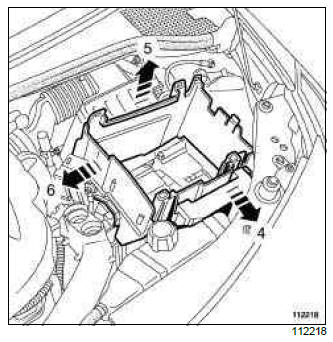Renault Clio: Battery: Precautions for the repair
I - SAFETY
1 - DANGER: RISK FROM ACID LINKED TO HANDLING
Sulphuric acid is a highly aggressive and toxic substance which corrodes most metals.
When handling batteries, it is very important to take the following precautions:
- protect your eyes by wearing goggles,
- wear acid-proof gloves and clothing.
IMPORTANT
A battery contains sulphuric acid, a dangerous substance.
If acid splashes on to your clothing, rinse all contaminated areas thoroughly in water.
If it comes into contact with the skin or eyes, seek medical attention.
2 - DANGER: RISK OF EXPLOSION LINKED TO CHARGING AND TO INCORRECT TIGHTENING OF THE TERMINALS.
IMPORTANT
To prevent damaging the battery or even causing it to explode, do not place any heat sources or create any sparks near a charging battery.
WARNING
Incorrect tightening could cause heating of contacts, starting or charging faults, sparking, or could cause the battery to explode.
When a battery is charging, oxygen and hydrogen are produced. The mixture of these two gases is explosive.
The smallest of sparks or heat sources can cause an explosion. The explosion is so strong that the battery can shatter and spray the acid into the surrounding atmosphere.
People nearby are at risk (exploded fragments, acid splashes). Acid splashes are dangerous. They also damage clothing.
Safeguarding against the danger of explosion, which can be caused by handling a battery carelessly, must be taken very seriously.
IMPORTANT
To avoid all risk of sparks, ensure that all electrical consumers are fully switched off.
When a battery is being charged inside a building, switch off the charger before connecting or disconnecting the battery.
Do not place any metallic items on the battery as this may create a short circuit across the terminals.
II - GENERAL RECOMMENDATIONS
WARNING
These vehicles are equipped with a battery with low water consumption. Topping up the electrolyte is therefore prohibited.
WARNING
Before disconnecting the battery:
- wait for the motor-driven fan assembly to stop,
- wait for the computer to finish saving (1 minute).
WARNING
Some vehicles are only fitted with " TB " (low height) batteries. To avoid damaging the bonnet, only refit a battery which is identical to the battery originally fitted.
Battery tray: Removal - Refitting

REMOVAL
I - REMOVAL PREPARATION OPERATION
- Remove the battery (see 80A, Battery, Battery: Removal - Refitting, 80A-1).
II - OPERATION FOR REMOVAL OF PART CONCERNED

- Unclip the power feed fuse board support (1).
- Remove the power feed fuse board support (2).

- Unclip the battery protective tray at (3).

- Keep the fuse board support away (4).
- Move away the battery protective shield (5) and (6).
- Remove the battery protective shield.
- Remove the air filter box (see Air filter unit: Removal - Refitting) (MR 392, 12A, Fuel mixture).

- Remove:
- the battery base shield bolts (7) (M8),
- the battery base shield bolt (8) (M6).
- Unclip the harness attached to the battery base shield.
- Remove the battery base shield.
REFITTING
REFITTING OPERATION FOR PART CONCERNED
- Refit the battery base shield and the mounting bolts.
- Torque tighten:
- the bolts (M8) of the battery base shield (21 Nm),
- the bolt (M6) of the battery base shield (8 Nm).
- Refit the air filter box (see Air filter unit: Removal - Refitting) (MR 392, 12A, Fuel mixture).
- Clip in place
- the battery protective tray,
- the power supply fuse board support.
- Refit the battery (see 80A, Battery, Battery: Removal - Refitting, 80A-1).

